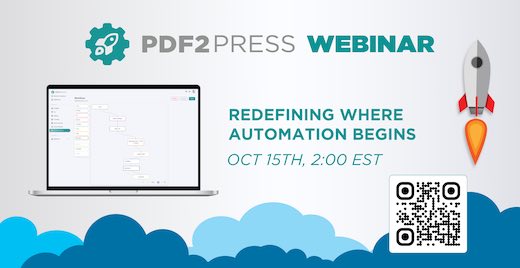By David Graves, CEO, Aleyant

When approaching automation in print-production, there is an immediate mental connection to the overall workflow processes. Sometimes the assumption is made that workflows start after the order has been received, typically manually entered, and sent to your prepress team. But an overall print-workflow is more complex throughout its cycle, including estimation, customer management, order-entry, inventory management, file intake, prepress, proof-creation, proof approvals, revisions, plating, printing, finishing, outsourcing, shipping, and invoicing.
When investigating which areas to focus on automating first, take a step back and identify your bottlenecks in the process involving potential time-savings, areas of manual-entry and redundant tasks. 55% of a job’s time is spent in estimating, job administration, scheduling, and prepress1.
Job Creation Through Web to Print
The onboarding of jobs once the estimation is agreed upon typically involves emails, manual entry into an MIS, downloading of files, and job ticket creation, which can lead to more emails back-and-forth, details getting lost, more manual-entry and then the proofs and revisions begin. It is worth discovering how many manual touchpoints exist before production begins. Each one increases the risk of missing details and possible rework or data re-entry.
Web-to-print systems have been a very good starting point to automate order-entry, allowing customers access to your products and pricing 24 hours a day. B2B portals/sites enable price consistency during order-intake, and the customized branding gives customers a concierge-like service. Customers being responsible for placing orders, making payments, and uploading the files into your environment is a must in today’s printing environment. Since over half of a print job’s time is spent in steps prior to hitting the press, such as job-tracking and scheduling, there is an opportunity for significant savings of time and labor-costs for print businesses.
Job Submission
Automation in the order process is vital for the success of printing companies. According to Napco Research, 81% of print jobs originate outside of web to print2. The art files associated with those jobs are sent through legacy channels (email, cloud services or thumb drives) which still require manual entry to get started. Having the ability to automate this part of the process is critical to expedite jobs into a workflow and is another opportunity for huge savings in time and labor.
As a print buyer makes selections and customizes their product, each selection can trigger changes in how their file is processed during prepress. Certain selections can determine whether color conversions need to happen and whether imposition needs to reflect a single-sided product versus a double-sided product. Automatic art-file fixes can also be triggered including adding bleed, resizing pages, or flattening transparencies. Proof approval can be automated, as well as downloading approved production files to a hot folder. But these prepress steps can also be automated using traditional email attachments, which trigger proof approvals without manual touches.
Automating Processes
After a job is created, printed, and shipped, the automation does not stop. Processes can be sent to an ERP, Inventory Management Systems, accounting programs, and even CRM solutions. Bringing automation to processes post-order fulfillment may feel like a very daunting process to undertake, but starting to analyze your bottlenecks can greatly impact your profit once automated. Companies may face internal detractors that incorrectly fear automating processes equates to making their roles obsolete. Giving them the assurance that their knowledge and expertise can be utilized where they are needed most, especially on very customized projects, will help with buy-in and internal adoption.
Companies that experience this evolution have the advantage of adapting to similarly evolving customer demands. They can improve efficiency, reduce costs, integrate with other tools in their technology stack mid-process or downstream, and offer a better overall customer experience. This competitive advantage is critical in today’s marketplace, and automation is central to long-term success.
Register for Aleyant’s PDF2Press webinar here.
1 Anthony Thirlby at Venn Holding
2 Napco Research
David Graves is the CEO of Aleyant and has over 30 years’ experience in the graphic arts industry. Aleyant provides integrated automation software to the printing industry since 2005. www.aleyant.com














